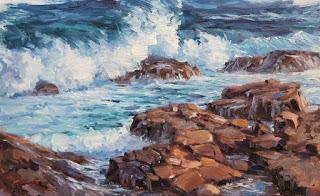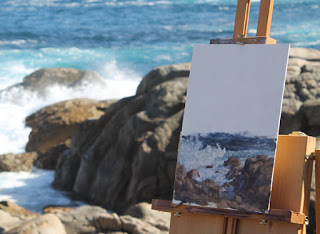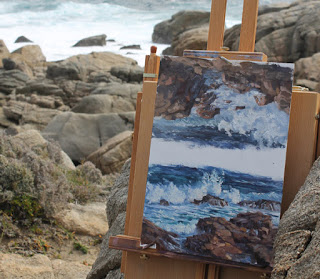Date: Saturday, August 11, 2012
Weather Forecast: Fine
As I mentioned in my last post, I’ve been thinking a lot about waves and seascapes lately. I’ve studied paintings of them, watched them at a variety of beaches and photographed and videoed them. And I’ve been working on a “seascape by design” over the last couple of weeks.
Today, with clear skies promised, I decided to head down to the Gap, near Albany, Western Australia, to do some wave painting en plein air.
When I arrived the sky was blue, as promised, and the ocean looked calm compared to what I’ve seen here in the past. But I wasn’t to be disappointed. There was a decent swell and a solid off-shore wind that picked up the tops of the biggest waves and blew them back out to sea. Almost every wave looked like a painting.
I found a spot among the rocks that sheltered me a little from the wind and I chose a scene. I used one half of a 255 x 355mm (10×14″) primed board. I was particularly interested in the temperature differences between rock and water and between areas of sunlight and shadow. The wave was assembled slowly, bit by bit, as it’s simply not possible to remember everything about a single wave, so I was always looking out for similar waves and taking note of different parts each time one crashed through.
Once I was done with the first painting, I flipped the board upside-down, turned to my left, and painted a second scene. This spot was crazy. Half the rocks that you can see below would keep disappearing completely under waves and there are submerged rocks that you can’t see in the painting that would appear every once in a while as a massive volume of water retreated. Choosing a composition was an interesting exercise!
I chose to spend quite a bit of time on the rocky structures in this one as I liked the angles and the way they created a natural lead-in for the painting . Subtle adjustment of warmer and cooler colours in the sunlit rocks helps to describe the planes. The flat water between the wave and the shore was always changing from a single blanket of white foam to almost completely clear water with beautiful blues and greens. I went for a combination of the two and showed the white foam breaking up with windows of clear water.
The two photos above show how the paintings finished up on site. When I got back to the studio, I did a little bit of cleaning up so I could use these paintings as references for larger pieces. You can see the results below.
And here are the obligatory on-site photos that every plein air blog needs. In the second shot you can see the first painting upside-down on the same board.
I’ll continue with my “Genesis of a Seascape” series soon.







